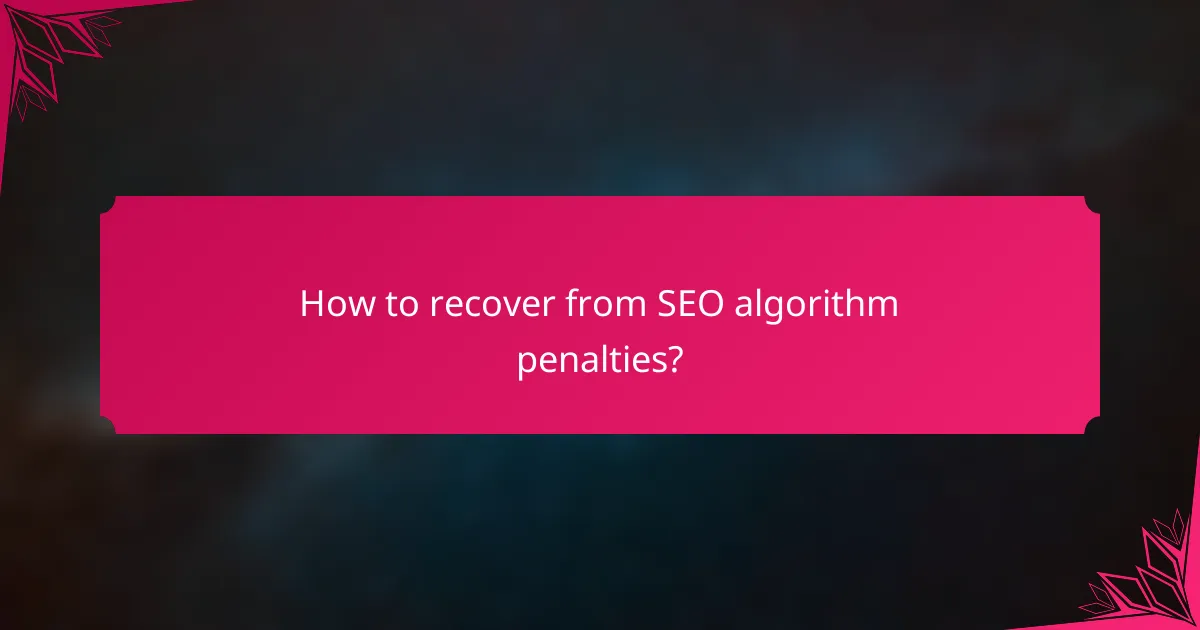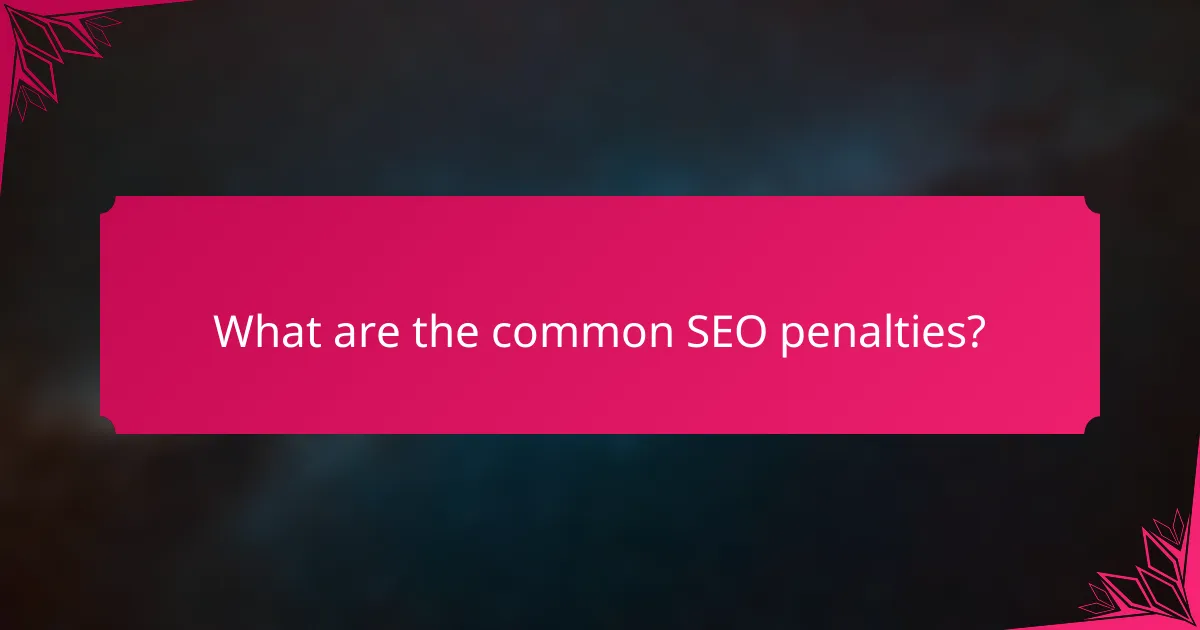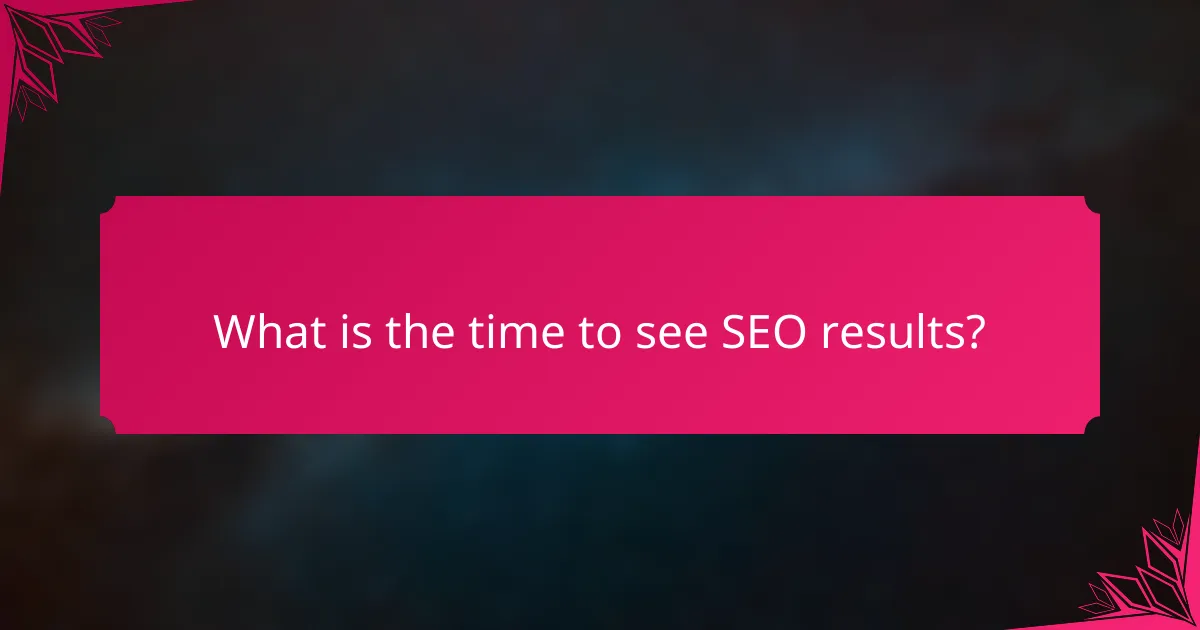Developing an effective SEO strategy requires a keen understanding of algorithm penalties, competition, and the time it takes to see results. Addressing penalties involves identifying specific issues and ensuring compliance with search engine guidelines, while analyzing competition helps in refining your approach. By evaluating competitors’ strengths and weaknesses, you can better position your website for success in search engine rankings.

How to recover from SEO algorithm penalties?
Recovering from SEO algorithm penalties involves identifying the specific penalty, addressing the underlying issues, and submitting a reconsideration request. This process can take time and requires a thorough approach to ensure that your website complies with search engine guidelines.
Identify the penalty type
Understanding the type of penalty your site has received is crucial for recovery. Penalties can be either manual, imposed by a human reviewer, or algorithmic, triggered by changes in search engine algorithms. Common algorithmic penalties include those related to link schemes, thin content, or keyword stuffing.
To identify the penalty type, check Google Search Console for any notifications or messages. If you notice a significant drop in traffic, it may indicate an algorithmic penalty, which can be confirmed by analyzing your site’s performance before and after algorithm updates.
Conduct a backlink audit
A backlink audit is essential for identifying harmful links that may have contributed to your penalty. Use tools like Ahrefs or SEMrush to analyze your backlink profile and identify low-quality or spammy links. Aim to focus on links from sites with low authority or those that appear irrelevant to your content.
Once identified, you can either disavow these links using Google’s Disavow Tool or reach out to webmasters to request their removal. Regular audits can help maintain a healthy backlink profile and prevent future penalties.
Fix on-page SEO issues
On-page SEO issues can also lead to penalties, so it’s important to address them. Start by reviewing your site’s content for quality, relevance, and keyword optimization. Ensure that your content is valuable and informative, avoiding practices like keyword stuffing or duplicate content.
Additionally, check for technical issues such as broken links, slow loading times, and poor mobile usability. Tools like Google PageSpeed Insights can help identify areas for improvement. Fixing these issues can enhance user experience and align your site with search engine standards.
Submit a reconsideration request
After addressing the identified issues, you can submit a reconsideration request to Google. This request should include a detailed explanation of the steps you’ve taken to rectify the problems that led to the penalty. Be honest and transparent about your efforts to comply with guidelines.
When drafting your request, provide specific examples of changes made, such as removed links or improved content. Keep in mind that it may take several weeks for Google to respond, so patience is key during this process.

What are the common SEO penalties?
Common SEO penalties are negative impacts on a website’s search engine rankings due to violations of search engine guidelines. These penalties can result from various factors, including low-quality content, manipulative link practices, or technical issues.
Panda penalty
The Panda penalty targets websites with low-quality or thin content. It assesses the overall quality of a site, focusing on factors like content originality, depth, and user engagement. Sites that fail to meet these quality standards may experience significant drops in rankings.
To avoid a Panda penalty, ensure your content is comprehensive, informative, and valuable to users. Regularly audit your site for low-quality pages and consider improving or removing them to enhance overall content quality.
Penguin penalty
The Penguin penalty focuses on the quality of backlinks pointing to a site. It penalizes websites that engage in manipulative link-building practices, such as buying links or using link farms. Affected sites may see a decline in their search rankings due to these unnatural link profiles.
To prevent a Penguin penalty, build a diverse and natural backlink profile by earning links from reputable sources. Regularly review your backlinks and disavow any that appear spammy or irrelevant to maintain a healthy link profile.
Hummingbird penalty
The Hummingbird penalty is less about direct penalties and more about how search engines interpret user intent. It emphasizes the importance of semantic search and context, rewarding sites that provide relevant and meaningful content. Websites that fail to align with user intent may see reduced visibility.
To align with Hummingbird’s focus, create content that answers specific questions and addresses user needs. Utilize long-tail keywords and natural language to improve relevance and enhance your site’s chances of ranking well for related searches.

How to analyze SEO competition?
To analyze SEO competition, start by identifying your main competitors and understanding their strengths and weaknesses in search engine rankings. This involves evaluating their keyword strategies, backlink profiles, and overall online presence.
Use tools like SEMrush
SEMrush is a powerful tool that provides insights into your competitors’ SEO strategies. You can analyze their organic search traffic, keyword rankings, and even their advertising efforts. By entering a competitor’s domain, you can uncover valuable data that helps you identify opportunities for improvement.
Consider using SEMrush’s keyword gap feature to compare your keyword rankings against those of your competitors. This can reveal keywords you may be missing and help you refine your own SEO strategy.
Evaluate keyword rankings
Assessing keyword rankings involves checking where your competitors rank for specific keywords relevant to your industry. Tools like Google Search Console or Ahrefs can help you track these rankings over time. Look for keywords that generate significant traffic for your competitors but are not yet targeted by your own site.
Focus on long-tail keywords that may have lower competition but can drive targeted traffic. These keywords often lead to higher conversion rates as they cater to specific user intents.
Assess backlink profiles
Backlinks play a crucial role in SEO, influencing your site’s authority and ranking potential. Use tools like Moz or Ahrefs to analyze your competitors’ backlink profiles. Look for high-quality backlinks that they have acquired, as this can inform your own link-building strategy.
Pay attention to the diversity and relevance of their backlinks. A strong backlink profile typically includes links from reputable sites within your niche, which can enhance your own site’s credibility when targeting similar sources.

What is the time to see SEO results?
SEO results typically take time to materialize, often ranging from a few months to over a year. The timeline depends on various factors including competition, the effectiveness of strategies employed, and the current state of the website.
Initial results in 3-6 months
In the first 3 to 6 months, you may start to see initial results from your SEO efforts. This period often includes improvements in organic traffic and keyword rankings, particularly for less competitive terms.
During this phase, focus on optimizing on-page elements such as title tags, meta descriptions, and content quality. Regularly updating your site with fresh content can also help accelerate early gains.
Significant changes in 6-12 months
Between 6 to 12 months, you can expect more significant changes in your SEO performance. By this time, your website should start ranking for more competitive keywords and experiencing a noticeable increase in organic traffic.
To maximize results, consider building high-quality backlinks and enhancing user experience. Monitoring analytics will help you identify which strategies are effective and where adjustments are needed.
Long-term strategies beyond 12 months
Long-term SEO strategies that extend beyond 12 months focus on sustaining and improving your rankings. At this stage, your website should have established authority and trust, leading to consistent organic traffic growth.
Continue to refine your content strategy, adapt to algorithm updates, and engage with your audience through social media and email marketing. Regularly auditing your SEO practices will ensure you stay competitive in your niche.

What factors influence SEO results timeline?
The timeline for SEO results is influenced by several key factors, including website authority, competition, and the nature of the strategies employed. Understanding these elements can help set realistic expectations for when to anticipate significant traffic and ranking improvements.
Website authority
Website authority refers to the credibility and trustworthiness of a site, which significantly impacts its ability to rank well in search engine results. Factors contributing to authority include the quality and quantity of backlinks, content relevance, and user engagement metrics.
To build authority, focus on acquiring high-quality backlinks from reputable sites in your niche. Engaging content that meets user needs can also enhance authority, as search engines favor sites that provide value to users.
Common pitfalls include neglecting on-page SEO elements and relying solely on low-quality backlinks, which can harm your authority. Regularly audit your backlink profile and content to ensure they align with best practices for building a strong online presence.
